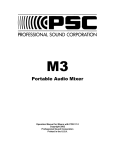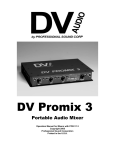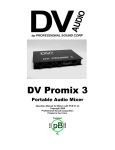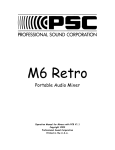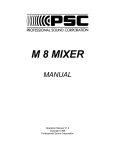Download Professional Sound Corporation M 8 Specifications
Transcript
DV Promix 1 Audio Production Tool Operation Manual for Mixers with PCB V1.3 Copyright 2008 Professional Sound Corporation Printed in the U.S.A. TABLE OF CONTENTS DESCRIPTION……………………………………………………………………………3 SAFETY WARNINGS……………………………………………………………………4 APPLICATIONS…………………………………………………………………………..4 FRONT PANEL LAYOUT…………………………………………………………..…...5 REAR PANEL LAYOUT……………………………………………………..…………..6 FUNCTIONS INPUTS……………………………………………………………………………7-8 A. BALANCED INPUT B. INPUT LEVELS C. MICROPHONE POWERING D. LOW CUT FILTER E. CHANNEL GAIN OUTPUTS…………………………………………………………………………..9 A. BALANCED OUTPUT B. OUTPUT LIMITER MONITOR………………………………………………………………………….9 A. HEADPHONE MONITOR OUTPUT MONITOR RETURN……………………………………………………………..9 A. TAPE RETURN MONITOR GAIN METER……………………………………………………………………………10 A. PEAK READING METER POWERING……………………………………………………………………….10 2 A. INTERNAL POWER, ALKYLINE BATTERIES B. EXTERNAL POWER CONSTRUCTION……………………………………………………………………11 A. CHASSIS B. ELECTRONIC TOPOLOGY C. ENVIRONMENTAL OPERATION INTERFACING……………………………………………………………………11-12 A. TO DV CAMS B. TO CONSUMER CAMCORDERS C. TO WIRELESS MICROPHONES WARRANTY AND NON-WARRANTY SERVICE…………………………………13 SPECIFICATIONS…………………………………………………………………….14 DECLARATION OF CONFORMITY……………………………...…………………15 DESCRIPTION Thank you for purchasing the Professional Sound Corporation DV ProMix 1 Audio Production Tool. PSC is confident that this new DV ProMix 1 Audio Production Tool has set new standards for portable audio production. Please feel free to contact us if you have any comments or questions concerning your new DV ProMix 1. Additionally, we invite you to share your suggestions for new products you would like to see developed. Professional Sound Corporation extends a six month warranty on parts and labor to all DV Promix 1 Audio Production Tool owners who return their warranty cards at the time of purchase. This warranty gives you specific rights, which are stated on the card, and enables us to keep you informed of product updates. The PSC DV Promix 1 Audio Production Tool provides all the functions necessary to produce studio quality recordings in the field. It’s user friendly features, rugged design and sonic purity make the DV Promix 1 perfect for DV production, electronic news gathering (ENG) electronic field production (EFP). 3 HEARING SAFETY WARNINGS: At Professional Sound Corporation, we care about your hearing both short term and long term. With that in mind, please heed the following warnings: Please be sure that you have read this entire manual before operating this mixer. While special attention has been given to your safety and hearing protection, the operator determines proper and safe operating levels. Please note the following: Always turn down the headphone volume before plugging in your headphones. Always operate your headphones at the lowest practical level. Be especially cautious in unknown or widely varying environments. Remember, your ears are your livelihood. Turn it down! APPLICATIONS • • • • • • DV Field Production Electronic News Gathering Location Recording (Dialogue and Music) Digital Recording Broadcast Remotes Desktop Mixing for Video Post Production 4 “MONITOR” Pop up variable gain trim for monitor return amp. “PRE-AMP” Pop up variable gain trim for balanced main input. “PHONES” Pop up volume control for headphone level. “BATT, EXT” Power switch, up for internal battery, down for external power or center off. “PWR” Two color LED indicating power. Green indicates batteries O.K. Red indicates low batteries. “80, 20, 150” High pass filter used to reduce wind rumble, etc. Center position is marked 20Hz and provides flat frequency response. Up position rolls off frequencies below 80Hz for moderate roll off, Down position rolls off frequencies below 150Hz for more severe roll off. “IN, OUT” These LEDs indicate when the input and output limiters are activated. You can use the “IN” LED to set the pre-amp gain and the “out” LED to help with the main fader setting. “LIM” Limiter switch. Up position activates the input and output limiters. Down position turns off the limiters. D/M, D, M Headphone selections, Up position “D/M” sends the direct signal (preamp input) to the left ear and sends the monitor amp signal to the right ear. The center position “D” sends the direct (preamp) signal to both ears. The down position “M” sends the monitor signal to both ears. “RC” The “RC” LED is “on” when the optional boom pole remote control is plugged in and activated. “FADER” Sets the overall level from the pre-amp to the output amplifier. It’s effect can be easily seen on the meter. “METER” Multi-color six LED peak reading meter. -18 to -3 are colored green, 0 is colored yellow and +3 is colored red for ease of use. 5 “HEADPHONES” Headphone jack. Can be used with headphones from 25 to 600 ohms. “BOOM REMOTE” Connection for optional boom pole remote control. It’s use allows the operator to set fader levels from the boom pole. “BALANCED MONITOT INPUT” Electronically balanced monitor return input. It will except signal levels from microphone level to line level. This input is used for tape return or talk back monitoring. “12T, DYN, 48PH” Microphone power switch. 12T position provides 12 volts AB mic power for 12T style microphones. DYN position provides no microphone power and is for use with dynamic microphones and line level signal sources. The 48PH position provides 48 volts for use with 48PH microphones. “BALANCED MAIN INPUT” Electronically balanced input for talent microphone. Very low noise pre-amp capable of taking microphone to line level signals. “-40, -10, 0” Balanced output signal level switch, -40dBv for microphone level, -10dBv for consumer line level, 0dBv for professional line level devices. “OUTPUT” Transformer balanced output. See above for level setting. “EXT PWR” External power jack. Center terminal positive. Usable voltage range of 7 to 16Vdc. 6 INPUT: A. BALANCED INPUT The PSC DV Promix 1 Audio Production Tool provides one input channel utilizing a three pin female XLR connector. The studio grade input circuitry is electronically balanced for improved RF rejection and in-field practicality. The XLR connector is wired as follows: Pin 1 shield (ground), Pin 2 Audio high (in phase), Pin 3 Audio low (out of phase). Balanced wiring enables longer cable runs without the worry of excessive noise due to nearby electromagnetic and radio frequency interference. These balanced inputs may be unbalanced if desired. Either pin 2 or 3 may be tied to ground (pin 1) to unbalance the input of the DV Promix 1. B. INPUT LEVELS The PSC DV Promix 1 Audio Production Tool can accommodate a wide range in input levels. Microphone levels of all types can be handled as well as line level signals. The input range of the DV Promix 1 Audio Production Tool is –60dBu to +4dBu. Thus the DV Promix 1 is compatible with all forms of consumer and professional audio equipment. The input level trim pot is located on the front panel of the DV ProMix 1. This pot is retractable for easy use. Simply press lightly on the knob and the knob will pop out for easy adjustment. After setting the pot to the proper level, simply press the knob down again and the pot will retract and stay flush mounted to the panel. Turning the Pre-Amp gain trim counter clock-wise lowers the gain of the first pre-amp. Turned fully counter clock-wise, the DV ProMix 1 will accept line level signals. Turn the Pre-Amp gain pot fully clock-wise, and the DV ProMix 1’s pre-amp is set for maximum gain. This setting is normally used with dynamic microphones such as Shure SM58’s tm, or Electro-Voice Re 50’s tm. Typical condenser microphones (powered microphones such as 48PH mics) will require less gain than a dynamic microphone and thus the pre-amp gain trim pot would normally be set somewhere around the 2:00 or 3:00 position. This input level gain setting are used to correctly interface sources of varying levels to the DV Promix 3’s preamplifiers. Correct level matching ensures maximum headroom and lowest possible noise floor. To correctly set the Pre-Amp gain trim pot, switch on the limiter switch, pop out the Pre-Amp gain pot knob and slowly raise the gain pot while operating the microphone with the expected audio source volume. (If you are going to record a whisper, then set the gain while whispering, if you are going to record a scream, then set the gain while screaming) As soon as the “Input” limiter LED begins to light, back off the Pre-Amp gain trim pot a just a little until the LED no longer lights. At this point, the Pre-Amp gain is properly set and you can press the pot inward to get it out of your way. C. MICROPHONE POWERING The DV Promix 1 Audio Production Tool can accommodate the most popular microphones used today. The microphone powering switch is located directly 7 above the Pre-Amp input XLR connector. This swirtch can be switched to either Dynamic (D), 48Phantom (48PH) or 12T microphone power. In the Dynamic position the mixer provides no microphone powering. This position is used with Dynamic Microphones, Line Level inputs and when using Wireless Receivers. In the 48 Phantom Position the mixer provides 48 volts DC to power 48PH microphones or simplex powered microphones with a range of 9 to 52 volts. Pin 1 is shield to ground while pins 2 and 3 carry 48 volts DC. The term “phantom” is derived from the fact that there is no voltage potential developed across a dynamic microphone transducer that would interfere with its operation. However, most portable wireless receivers will not operate properly with 48PH turned on. We strongly recommend setting inputs to dynamic for use with all wireless systems. In the 12T setting, the DV ProMix 1 will provide 12T microphone powering for use with microphones designed for this powering standard. This is an older standard used primarily in the Motion Picture Audio (feature film) sound recording business. Microphones designed for this type of powering are typically made by the German Microphone makers such as Sennheiser or Scheops. The 12T microphone power standard provides a 12 volt potential between pins 2 and 3 with pin 2 being positive with respect to pin 3. Please note that 48PH must not be used with 12T microphones and vice-versa. Always use the correct power for the microphone being used. Failure to do so may damage the microphone and/or the DV ProMix 1. D. LOW CUT FILTER The Pre-Amp input of the DV Promix 1 Audio Production Tool is equipped with a low cut (high pass) filter. This filter is activated via the three way switch located on the front panel. These filters will attenuate all frequencies below a preset frequency at a rate of 6dB per octave. When set at “20Hz”, frequencies below 20 Hz are effectively rolled off with the mixer operating at full frequency response. Optional low cut filter settings of 80Hz and 150Hz will roll off the frequencies below these figures at a rate of 6dB per octave (-3dB level at 80Hz and 150Hz respectively). Low cut filtering is important in location recording where wind noise can cause pre-amplifier overload. This effect can be minimized by switching the low cut filter setting to either an 80Hz or 150Hz cutoff. The low cut filter switches are located on the front of the DV Promix 1. E. CHANNEL GAIN The overall volume of the audio to be recorded is controlled by the main fader. Rotating the fader clock-wise increases the audio level (signal volume). Rotating the fader pot counter clock-wise lowers the audio level. Proper operating level is determined by using the LED meter. (see meter section of this manual) 8 OUTPUT: A. BALANCED OUTPUT (XLR Male Connector) The DV Promix 1 Audio Production Tool contains a very high quality transformer balanced output. This transformer and the related drive circuitry has been designed to provide wide bandwidth, low distortion and real-world ease of use. This output is available via the rear panel mounted male XLR connector. This output is switchable between Professional Line Level (0dBv), Consumer Line Level (-10dBv) or Microphone Level (-40dBv). B. OUTPUT LIMITERS. The limit threshold (activation level) is factory set at +3 on the meter. The limiters compress the signal at approximately 2.7 to 1 ratio. This is to say an increase of 2.7dB in input signal will result in only a 1dB increase in output signal. Most video cameras have limited audio track headroom and can easily be overloaded resulting in distortion of the recorded audio. For this reason, the DV Promix 1 contains limiters that are controlled automatically for ease of use and high quality recordings. C. HEADPHONE OUTPUT The Headphone output is located on the rear panel of the mixer. The DV Promix 1 Audio Production Tool’s headphone amplifier circuitry is designed to drive virtually any headphone with an impedance rating of 25 to 600 Ohms. The headphone circuitry is controlled by the use of a switch and a volume control that are conveniently located on the front panel. The switch is used to control what the operator listens to. It allows the operator to chose between monitoring “D” (Direct) audio that is present on the ProMix 1’s output or in the “M” (Monitor) the headphones are fed with audio from the Monitor input. “Monitor” audio that may be fed back from the headphone jack of the camera ensuring that audio has been recorded. This “Monitor” function is commonly called tape confidence monitoring. In the D/M position, your left ear will hear “Direct” audio and your right ear will hear “Monitor” audio *SAFETY NOTE* ALWAYS TURN DOWN THE HEADPHONE VOLUME BEFORE PLUGGING IN YOUR HEADPHONES. D. MONITOR INPUT The DV Promix 1 Audio production Tool is equipped with a 3 pin female XLR jack for use in monitoring talk back signals as well as tape confidence signals. These levels are adjusted using the re-tractable trim pot on the front panel of the DV ProMix 1. 9 METERS: A. PEAK READING METER The DV Promix 1 Audio Production Tool is equipped with an LED meter. We designed this meter to be easy to read and camera emulating. Because the most common use of this type of mixer is with DV Cams, we designed the DV Promix 1’s meter to emulate the peak reading attributes found on many DV Cams. In this manor, you can be confident of your recording levels even when the DV Cam is being fed via cable or wireless transmission. The LED’s used on the DV ProMix 1’s meter are color coded for easy use. For signals up to –3dBv, the LED’s are GREEN in color. The 0dBv LED is AMBER in color and signals of +3dBv and above are shown as RED. In this manner, you need not concentrate on the panel markings, just note the colors. Always have some Green LEDs on, Occasionally have the Amber LED flashing, and try and keep the red LED off as much as possible. By monitoring your audio signal level and riding the main fader to adjust the levels as mentioned above, you will be assured of high quality audio. POWERING: A. INTERNAL POWER, ALKALINE BATTERIES Two “9 Volt” alkaline batteries can used to power the DV Promix 1 Audio Production Tool. These batteries are housed in a convenient battery compartment located on the side panel of the mixer. When using alkaline batteries, you can expect 4 to 6 hours of operation under normal circumstances. Note: Never store your DV Promix 1 Audio Production Tool for extended periods of time with alkaline batteries installed in the mixer. There is a possibility that the batteries may leak causing corrosion of the mixer. Battery leakage and the resulting corrosion damage is not covered under the DV Promix 1 warranty. B. EXTERNAL POWER The PSC DV Promix 1 Audio Production Tool can also be externally powered from any source of DC power from 7 to 16 Vdc. The DV ProMix 1 consumes approximately 70 mA over this voltage range. The external power connector is located on the rear panel of the mixer. Pin outs of this connector are as follows: Center Pin (+) Positive Outside Ring (-) Negative This external DC input is protected from reverse polarity. If you inadvertently connect external power of the incorrect polarity, the DV ProMix 1 will not be damaged; it simply will not power up. 10 CONSTRUCTION A. CHASSIS The new DV Promix 1 Audio Production Tool chassis has been designed for high degree of torsional rigidity. This increased rigidity provides a stable base for the DV ProMix 1’s modern electronics. The complete chassis is formed from 0.040” aircraft aluminum. All punching is done on a computer controlled rotary turret punch press for extreme accuracy. In addition, through careful design, we have managed to keep the overall weight of the DV Promix 1 Mixer to 1Lb, 11oz. (0.8Kg) Total. The mixers sheet metal is hand-formed using various press brake setups. The housing parts are then painted. All silk-screening is then applied. B. ELECTRONIC TOPOLOGY The new DV Promix 1 Audio Production Tool was designed from a clean sheet of paper. It utilizes completely new circuitry designs based upon the latest advances in semi conductor technology. This new design uses modern semi-conductors from Linear Technology, National Semiconductor and Texas Instruments to name but a few. These operational amplifiers, voltage regulators and precision voltage references feature low power consumption, low noise and low distortion. C. ENVIRONMENTAL OPERATION Your new DV Promix 1 Audio Production Tool has been designed to operate under extreme field conditions. The electronics have been designed to operate over a temperature range of -4 to 158 degrees Fahrenheit (-20 to +70C) less the affects on batteries. This in addition to the DV Promix 1’s ability to operate under high humidity conditions makes it perfect for harsh field conditions. INTERFACING A. TO PROFESSIONAL DV CAMS (XLR CONNECTOR): The PSC DV Promix 1 Audio Production Tool is especially designed for easy interfacing with all popular DV Cameras. The DV Promix 1 is equipped with a XLR male connector on the rear panel. This XLR output can provide audio at either Professional Line Level (0dBv), Consumer Line Level (-10dBv) or Microphone Level (-40dB). This output is normally used to feed audio to any device with a balanced input. You can connect your DV Promix 1 to any camera with a XLR input connector using a standard XLR microphone cable. Keep in mind that you must match up the output level of the DV Promix 1 to the input level required by your camera. I.E. if your camera has microphone level XLR inputs, then set the DV Promix 1’s output level switches to “MIC” (-40dBv). On the other hand, if your camera excepts line level inputs, then you may set the output level switches to “Line” (0dBv) 11 B: TO PRO-SUMER CAMERAS: The PSC DV Promix 1 can also be used with Semi-pro video cameras by setting the output level switch to –10dBv and then connecting to the video camera and setting the video camera to line level or if it is not switch-able, use the cameras “line” input. Alternatively, you can set the DV ProMix’s output level switch to – 40dBV and then feed the output signal into the video cameras “Mic” input connector. C: TO WIRELESS MICROPHONES: Receivers: The DV Promix 1 Audio Production Tool will easily accept the output signal from virtually any wireless receiver. It can accept microphone or line level signal via a simple Pre-amp gain trim pot setting. Please note that most wireless receivers are not compatible with 48PH. You should always set the DV Promix 1’s microphone powering switch to “D” dynamic when using wireless receivers. Transmitters: The DV Promix 1 Audio Production Tool can also be used to send audio signals to DV Cams via wireless transmitters. The use of transmitters is normally accomplished by connecting the DV Promix 1’s output XLR to the audio input of the specific transmitter. Many transmitter manufacturers supply application specific cables for this purpose. The DV Promix 1 has been designed to minimize RF interference through the use of a transformer balanced output and other RF filtering. It is important to note that transmitter placement greatly affects transmit range and clarity. For best results, transmitters should be mounted away from the DV ProMix 1’s metal surface allowing unimpeded RF radiation. When the DV ProMix 1 is worn over the shoulder of the operator, you should mount the wireless transmitters to the shoulder strap for best operation. 12 WARRANTY AND NON-WARRANTY SERVICE In the unlikely event your DV Promix 1 Audio Production Tool requires service it should be carefully packed and shipped prepaid to: Professional Sound Corporation Service Department 28085 Smyth Drive Valencia, CA 91355 USA PH 661-295-9395 FAX 661-295-8398 E-mail [email protected] Please call before shipping your DV ProMix 1. We may be able to solve your problem via the phone. During our 22 years in business, many products have been shipped in to us for service with only incorrect switch settings. WARRANTY: Complete details of the PSC DV Promix 1 Audio Production Tool warranty are given on the enclosed blue warranty registration card. If you did not receive one, please contact your local dealer or call us directly. 13 SPECIFICATIONS Size: 5.750” x 4.750” x 1.900” (146mm x 120mm x 48mm) Weight: 1lb, (0.45Kg) Temp Range: -4 to +158F (-20 to +70C) Batteries: 2x 9 Volt Alkaline External Power: 7 to 16Vdc, 2.5mm pin, center positive Case Material: 0.040” Aircraft Aluminum Finish: Semi Matt Black Paint with Grey Silk Screening Global Gain: 70dB Freq. Response: 20-20Khz +/-1dB Signal to Noise: 128dB EIN 150 Ohms Distortion: 00.1% THD Low Cut Filter: 80Hz, 150Hz 6dB/Octave Mic Power: DYN, 48 PH, Limiter: 1mS Attack, 100 mS Release 2.7:1 Ratio Warranty: 6 Months, Limited Copyright 2008, Professional Sound Corp. This manual and the complete DV Promix 1 Audio Production Tool design is protected under various state, federal and international copyright and trade secret laws. No portion of this manual or any DV Promix 1 Audio Production Tool technologies may be reproduced without the specific written permission of PSC. All rights reserved. This manual and all DV Promix 1 Audio Production Tool specifications subject to change without notice. 14 CE DECLARATION OF CONFORMITY EMC: This product is in compliance with the Electromagnetic Compatibility Directive, 89/336/EEC as defined in EN 50081-1, EN55022 and EN 50082-1. IEC801-2, IEC801-3 and IEC801-4. LVD: This product is in compliance with the requirements of the Low Voltage Directive, 73/23/EEC. 93/68/EEC as defined in EN60065, 1993 and/or EN60950/A1/A2/A3: 1995 TRADE NAME: MODEL: PSC DV ProMix 1 RESPONSIBLE PARTY: Professional Sound Corp. 28085 Smyth Drive Valencia, CA 91355 USA CONTACT PERSON: Ronald Meyer (661) 295-9395 TYPE OF PRODUCT: Pre-amplifier MANUFACTURER: Professional Sound Corp. 28085 Smyth Drive Valencia, CA 91355 USA We hereby declare that the equipment bearing the trade name and model number listed above has been tested in accordance with the requirements contained in the above listed directives. All necessary steps have been taken and are in force to assure that production units manufactured will conform to Directive guidelines. August 2004 Professional Sound Corporation. 15















